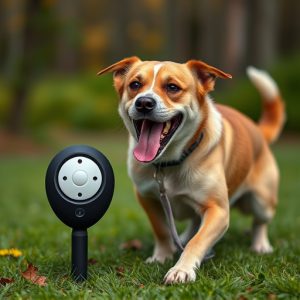LED-Powered Dog Repellents: Stationary vs. Mobile Comparisons for Effective Training
This text compares stationary and mobile dog repellents, highlighting their distinct features and ap…….
This text compares stationary and mobile dog repellents, highlighting their distinct features and applications. Stationary repellents, installed outdoors, use scent deterrents or noise to protect defined areas like yards. In contrast, mobile repellents offer flexibility, employing technologies like ultrasonic sounds and LED lights that can be moved between locations. LEDs prove more effective for fixed locations due to their visual barrier properties, but mobile repellents with LEDs may lose effectiveness as dogs adapt. When choosing, consider area size, portability needs, and budget: stationary for consistent protection in specific areas, and mobile for temporary solutions or variable terrain.
“Discover the ultimate solution to keep your spaces pet-friendly with an innovative electronic dog repeller featuring LED light. This comprehensive guide explores the world of dog deterrents, highlighting the unique benefits of LED technology. We break down the different types and their functionality, offering insights into stationary vs. mobile repellers.
Learn which option suits your needs best, considering factors like coverage area and convenience. From understanding the science behind these devices to making an informed choice, this article is your go-to resource for effective dog repeller solutions.”
- Understanding Dog Repellents: Types and Their Functionality
- The Role of LED Lights in Dog Deterrence
- Comparing Stationary and Mobile Repellers: Features and Benefits
- Choosing the Right Dog Repeller: Considerations for Effective Use
Understanding Dog Repellents: Types and Their Functionality
Dog repellents are designed to discourage dogs from entering or lingering in specific areas, protecting both property and pets. They come in various types, each with unique functionality and applications. A key distinction lies between stationary and mobile repellents. Stationary repellents, often installed outdoors, use scent-based deterrents or loud noises to frighten dogs away. These are ideal for defining and securing perimeters around yards, gardens, or specific structures.
On the other hand, mobile dog repellents offer versatility, allowing users to move them from one location to another as needed. This type might employ ultrasonic sounds or LED lights with motion-sensing capabilities. A comparison between stationary and mobile options reveals that while stationary repellents provide consistent protection for defined areas, mobile ones give users greater flexibility, making them suitable for temporary or variable situations.
The Role of LED Lights in Dog Deterrence
LED lights play a significant role in modern dog repellents, offering an innovative approach to deterring canine intruders. Unlike traditional methods that rely solely on sound or scent, electronic dog repellers with LED lights provide a multi-sensory deterrent. The bright, flashing lights can startle dogs and trigger their natural instincts to avoid the area, especially when combined with ultrasonic sounds or specific frequencies.
When comparing stationary and mobile dog repellents, LED lights are often more effective in fixed locations due to their ability to create a visual barrier. Stationary devices with built-in LED lighting can be strategically placed to illuminate problem areas, making them less appealing to dogs. In contrast, while mobile repellents with LEDs can be handy for temporary deterrence, their effectiveness might wane over time as dogs become accustomed to the light pattern, necessitating constant movement or additional sensory cues.
Comparing Stationary and Mobile Repellers: Features and Benefits
When it comes to keeping dogs away from certain areas, there are two primary types of repellers to consider: stationary and mobile. Stationary dog repellents are typically devices that are fixed in one location, often using ultrasonic sounds or spray to deter canines. These are usually powered by electricity and require no additional effort once installed. They’re ideal for specific spots like gardens or patios where the protection is needed consistently.
On the other hand, mobile repellers offer versatility as they can be easily carried and moved around. These portable devices often employ LED lights and ultrasonic waves, sometimes with added features like motion sensors. Mobile repellents are perfect for temporary solutions or areas that require frequent changes in barrier placement, such as outdoor events or different seasons when canine intruders may vary.
Choosing the Right Dog Repeller: Considerations for Effective Use
When considering a dog repeller, one of the primary decisions to make is between stationary and mobile options. A stationary dog repeller is ideal for securing a specific area like a patio or garden. It’s effective in creating a consistent barrier that deters dogs through sound and light without requiring constant movement or manual operation.
In contrast, mobile dog repellers offer versatility, perfect for those who need to relocate the device frequently. These are excellent choices for parks, public spaces, or areas with variable terrain. Mobile options often incorporate LED lights that flash or emit pulsating patterns to startle dogs, coupled with ultrasonic sounds that are inaudible to humans but irritating to canine ears. Consider your specific needs, the area you want to protect, and whether portability is essential before making your choice between these two types of dog repellers.
When it comes to keeping unwanted canine visitors at bay, both stationary and mobile dog repellents offer effective solutions. However, understanding the unique features of each type is key to choosing the best fit for your needs. While stationary repellers provide consistent protection in a specific area, mobile options offer versatility for those who need coverage while on the move. In terms of technology, LED lights enhance their deterrence capabilities, making them suitable for various settings and preferences. By carefully considering your situation and budget, you can select an ideal dog repeller that combines functionality with convenience, ensuring peace and quiet in your desired spaces.


